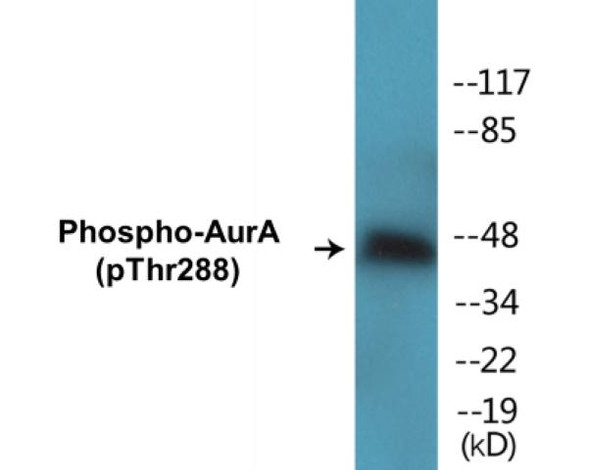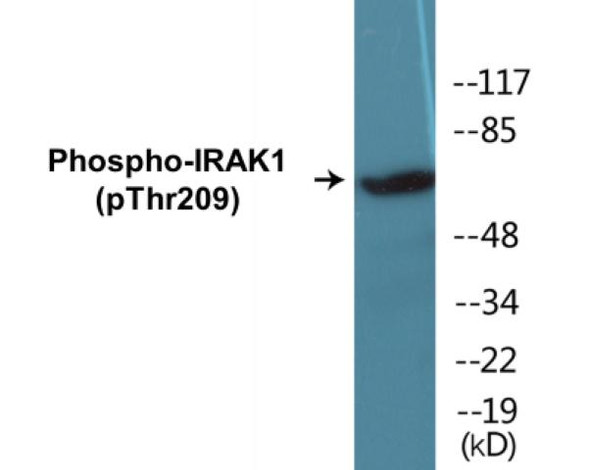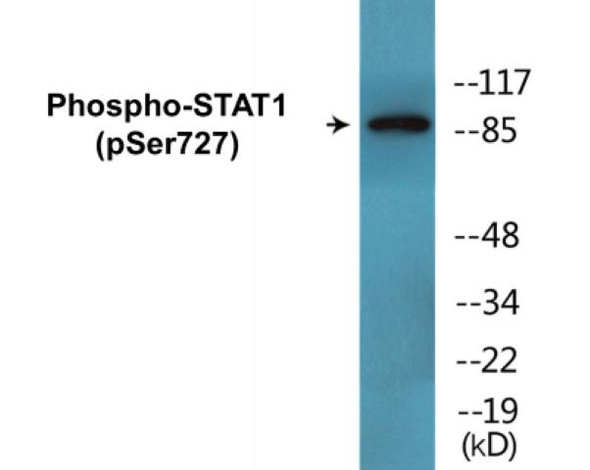Description
AurA (Phospho-Thr288) Cell-Based ELISA Kit
The AurA (Phospho-Thr288) Cell-Based ELISA Kit is a convenient, lysate- free, high throughput and sensitive assay kit that can monitor AurA phosphorylation and expression profile in cells. The kit can be used for measuring the relative amounts of phosphorylated AurA in cultured cells as well as screening for the effects that various treatments, inhibitors (ie. siRNA or chemicals), or activators have on AurA phosphorylation.
How does our AurA (Phospho-Thr288) Fluorometric Cell-Based ELISA Kit work?
Qualitative determination of AurA (Phospho-Thr288) concentration is achieved by an indirect ELISA format. In essence, AurA (Phospho-Thr288) is captured by AurA (Phospho-Thr288)-specific primary (1°) antibodies while Dye 1-conjugated and Dye 2-conjugated secondary (2°) antibodies bind the Fc region of the 1° antibody. Through this binding, the dye conjugated to the 2° antibody can emit light at a certain wavelength given proper excitation, hence allowing for a fluorometric detection method. Due to the qualitative nature of the Cell-Based ELISA, multiple normalization methods are needed:
| 1. | A monoclonal antibody specific for human GAPDH is included to serve as an internal positive control in normalizing the target RFU values. |
| 2. | An antibody against the nonphosphorylated counterpart of AurA (Phospho-Thr288) is also provided for normalization purposes. The RFU values obtained for non-phosphorylated AurA can be used to normalize the RFU value for phosphorylated AurA. |
AurA (Phospho-Thr288) Fluorometric Cell-Based ELISA Kit -Information
| Product Name: | AurA (Phospho-Thr288) Fluorometric Cell-Based ELISA Kit |
| Product Code/SKU: | FBCAB00026 |
| Description: | The AurA (Phospho-Thr288) Fluorometric Cell-Based Phospho ELISA Kit is a convenient, lysate-free, high throughput and sensitive assay kit that can monitor AurA (Phospho-Thr288) protein phosphorylation and expression profile in cells. The kit can be used for measuring the relative amounts of phosphorylated AurA (Phospho-Thr288) in cultured cells as well as screening for the effects that various treatments, inhibitors (ie. siRNA or chemicals, or activators have on AURKA phosphorylation. |
| Dynamic Range: | > 5000 Cells |
| Detection Method: | Fluorometric |
| Storage/Stability: | 4°C/6 Months |
| Reactivity: | Human, Mouse, Rat |
| Assay Type: | Cell-Based ELISA |
| Database Links: | Gene ID: 6790, UniProt ID: O14965, OMIM #: 603072, Unigene #: Hs.250822 |
| Format: | Two 96-Well Plates |
| NCBI Gene Symbol: | AURKA |
| Sub Type: | Phospho |
| Target Name: | Phospho-AurA (Thr288) |
Kit Principle
Figure: Schematic representation of Assay Genie Cell-Based Fluorometric ELISA principle
Kit components | Quantity |
| 96-Well Black Cell CultureClear-Bottom Microplate | 2 plates |
| 10X TBS | 24 ml |
| Quenching Buffer | 24 ml |
| Blocking Buffer | 50 ml |
| 15X Wash Buffer | 50 ml |
| Primary Antibody Diluent | 12 ml |
| 100x Anti-Phospho Target Antibody | 60 µl |
| 100x Anti-Target Antibody | 60 µl |
| Anti-GAPDH Antibody | 110 µl |
| Dye-1 Conjugated Anti-Rabbit IgG Antibody | 6 ml |
| Dye-2 Conjugated Anti-Mouse IgG Antibody | 6 ml |
| Adhesive Plate Seals | 2 seals |
Additional equipment and materials required
The following materials and/or equipment are NOT provided in this kit but are necessary to successfully conduct the experiment:
- Fluorescent plate reader with two channels at Ex/Em: 651/667 and 495/521
- Micropipettes capable of measuring volumes from 1 µl to 1 ml
- Deionized or sterile water (ddH2O)
- 37% formaldehyde (Sigma Cat# F-8775) or formaldehyde from other sources
- Squirt bottle, manifold dispenser, multichannel pipette reservoir or automated microplate washer
- Graph paper or computer software capable of generating or displaying logarithmic functions
- Absorbent papers or vacuum aspirator
- Test tubes or microfuge tubes capable of storing ≥1 ml
- Poly-L-Lysine (Sigma Cat# P4832 for suspension cells)
- Orbital shaker (optional)
Kit Protocol
This is a summarized version of the kit protocol. Please view the technical manual of this kit for information on sample preparation, reagent preparation and plate lay out.
| 1. | Seed 200 µl of desired cell concentration in culture medium into each well of the 96-well plates. For suspension cells and loosely attached cells, coat the plates with 100 µl of 10 µg/ml Poly-L-Lysine (not included) to each well of a 96-well plate for 30 minutes at 37°C prior to adding cells. |
| 2. | Incubate the cells for overnight at 37°C, 5% CO2. |
| 3. | Treat the cells as desired. |
| 4. | Remove the cell culture medium and rinse with 200 µl of 1x TBS, twice. |
| 5. | Fix the cells by incubating with 100 µl of Fixing Solution for 20 minutes at room temperature. The 4% formaldehyde is used for adherent cells and 8% formaldehyde is used for suspension cells and loosely attached cells. |
| 6. | Remove the Fixing Solution and wash the plate 3 times with 200 µl 1x Wash Buffer for 3 minutes. The plate can be stored at 4°C for a week. |
| 7. | Add 100 µl of Quenching Buffer and incubate for 20 minutes at room temperature. |
| 8. | Wash the plate 3 times with 1x Wash Buffer for 3 minutes each time. |
| 9. | Dispense 200 µl of Blocking Buffer and incubate for 1 hour at room temperature. |
| 10. | Wash 3 times with 200 µl of 1x Wash Buffer for 3 minutes each time. |
| 11. | Add 50 µl of Primary Antibody Mixture P to corresponding wells for AurA (Phospho-Thr288) detection. Add 50 µl of Primary Antibody Mixture NP to the corresponding wells for total AurA detection. Cover the plate with parafilm and incubate for 16 hours (overnight) at 4°C. If the target expression is known to be high, incubate for 2 hours at room temperature. |
| 12. | Wash 3 times with 200 µl of 1x Wash Buffer for 3 minutes each time. |
| 13. | Add 50 ul of Secondary Antibody Mixture to corresponding wells and incubate for 1.5 hours at room temperature in the dark. |
| 14. | Wash 3 times with 200 µl of 1x Wash Buffer for 3 minutes each time. |
| 15. | Read the plate(s) at Ex/Em: 651/667 (Dye 1) and 495/521 (Dye 2). Shield plates from direct light exposure. |
| 16. | Wash 3 times with 200 µl of 1x Wash Buffer for 5 minutes each time. |
AurA (Phospho-Thr288) - Protein Information
| UniProt Protein Function: | AurA: a member of the AUR family of kinases. A cell cycle-regulated serine/threonine protein kinase that is overexpressed in many tumor cell lines. Regulated by phosphorylation-dependent proteasomal degradation. Localized to mitotic centrosomes and spindle microtubules and is required for centrosome maturation. Loss of Aurora A leads to defective mitotic spindles and gross errors in chromosome segregation. Required for centrosome duplication and chromosome segregation. Overexpression in culture drives transformation and aneuploidy, and negatively regulates p53. Amplified or overexpressed in many tumors or cell lines. Found as a skin tumor susceptibility gene in mouse, and a human SNP in a degradation domain is weakly cancer-associated and undergoes allele-specific amplification. Inhibitors: VX-680, ZM447439, Hesperadin, SNS-595. |
| UniProt Protein Details: | Protein type:Protein kinase, Other; Protein kinase, Ser/Thr (non-receptor); EC 2.7.11.1; Oncoprotein; Kinase, protein; Other group; AUR family Chromosomal Location of Human Ortholog: 20q13 Cellular Component: microtubule cytoskeleton; germinal vesicle; axon hillock; centrosome; pronucleus; spindle microtubule; perinuclear region of cytoplasm; spindle; midbody; spindle midzone; spindle pole centrosome; cytosol; nucleus; condensed nuclear chromosome, pericentric region Molecular Function:protein serine/threonine kinase activity; protein binding; ubiquitin protein ligase binding; protein serine/threonine/tyrosine kinase activity; histone serine kinase activity; protein kinase binding; ATP binding; protein kinase activity Biological Process: spindle stabilization; mitosis; regulation of centrosome cycle; positive regulation of mitosis; protein amino acid autophosphorylation; regulation of protein stability; regulation of cytokinesis; protein amino acid phosphorylation; mitotic centrosome separation; mitotic spindle organization and biogenesis; centrosome localization; anaphase-promoting complex-dependent proteasomal ubiquitin-dependent protein catabolic process; cell division; positive regulation of proteasomal ubiquitin-dependent protein catabolic process; mitotic cell cycle; G2/M transition of mitotic cell cycle; negative regulation of protein binding; spindle assembly involved in female meiosis I; negative regulation of apoptosis; anterior/posterior axis specification Disease: Colorectal Cancer |
| NCBI Summary: | The protein encoded by this gene is a cell cycle-regulated kinase that appears to be involved in microtubule formation and/or stabilization at the spindle pole during chromosome segregation. The encoded protein is found at the centrosome in interphase cells and at the spindle poles in mitosis. This gene may play a role in tumor development and progression. A processed pseudogene of this gene has been found on chromosome 1, and an unprocessed pseudogene has been found on chromosome 10. Multiple transcript variants encoding the same protein have been found for this gene. [provided by RefSeq, Jul 2008] |
| UniProt Code: | O14965 |
| NCBI GenInfo Identifier: | 27923855 |
| NCBI Gene ID: | 6790 |
| NCBI Accession: | O14965.2 |
| UniProt Secondary Accession: | O14965,O60445, O75873, Q9BQD6, Q9UPG5, E1P5F9, |
| UniProt Related Accession: | O14965 |
| Molecular Weight: | 403 |
| NCBI Full Name: | Aurora kinase A |
| NCBI Synonym Full Names: | aurora kinase A |
| NCBI Official Symbol: | AURKA |
| NCBI Official Synonym Symbols: | AIK; ARK1; AURA; BTAK; STK6; STK7; STK15; AURORA2; PPP1R47 |
| NCBI Protein Information: | aurora kinase A; ARK-1; hARK1; aurora 2; Aurora-A kinase; IPL1-related kinase; aurora-related kinase 1; aurora/IPL1-like kinase; serine/threonine kinase 6; aurora/IPL1-related kinase 1; breast tumor-amplified kinase; breast-tumor-amplified kinase; serine/threonine-protein kinase 6; serine/threonine protein kinase 15; serine/threonine-protein kinase 15; serine/threonine-protein kinase aurora-A; protein phosphatase 1, regulatory subunit 47 |
| UniProt Protein Name: | Aurora kinase A |
| UniProt Synonym Protein Names: | Aurora 2; Aurora/IPL1-related kinase 1; ARK-1; Aurora-related kinase 1; hARK1; Breast tumor-amplified kinase; Serine/threonine-protein kinase 15; Serine/threonine-protein kinase 6; Serine/threonine-protein kinase aurora-A |
| Protein Family: | Aurora kinase |
| UniProt Gene Name: | AURKA |
| UniProt Entry Name: | AURKA_HUMAN |







